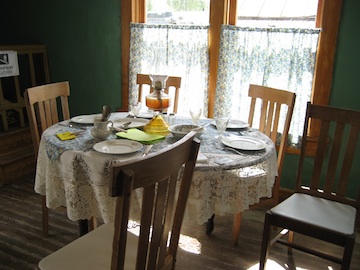


The Crow Wing County Fair runs for 5 days each summer, from Tuesday through Saturday during (roughly) the first week of August. The Historical Society maintains several exhibits of historical interest that are open for public access. We are in the northwest corner of the exhibit area, just south of the carnival and rides.
The exhibits are staffed by volunteers. If you would like to volunteer for a three-hour shift (10-1, 1-4, 4-7, 7-10), Please contact the Historical Society at 829-3268. You don't need to be a member of the Society to volunteer, but if you are interested enough to volunteer, why not become a member?
The Carbine House restoration page has information about the project to restore the Carbine House with funding via a Legacy Grant.
The gallery below will give you an idea of what's available at the fair. Click on any picture to see a larger (800x600 pixel) version.

The main exhibit building is the General Store - a reproduction of what a small dry goods store might look like in the late 19th century. The back area has items in general use in times gone by and also a few places to rest one's weary feet.

The Blacksmith building was built around 1910 of rough sawn lumber. It has a dirt floor and many handmade tools. Demonstrations of old-time blacksmithing techniques provided by Jeremy Knippel and Roy Heppner are scheduled throughout the day.
Next to the shop is a collection of tractors and small engines exhibited by the Old Homestead Power Club since 2005. Club members Greg Olson and Gerald Niesen provide demonstrations.

This schoolhouse was built about 1887 by Herbert C. Hughey on his farm at South Long Lake. Everyone walked to school (uphill both ways, of course). Water was carried over from a nearby farm and with no indoor plumbing, everyone had to use the outhouse.
After the rural schools were closed in the 1960s this school was moved to its current location at the fairgrounds. Supervised coloring contests for school-aged children are held throughout the day.

The log structure within the Carbine House was discovered in the early 1960s when the YMCA began dismantling the house then at Oak and 7th Streets (624 Oak Street) and found the log house under the exterior siding.
According to the 1928 “Platted Real Property Assessment” the house was built in 1868. It was first located in a ravine between the YMCA and a building to the north. The cabin was raised twice to higher levels as the ravine was filled. In 1928 the house had water, sewer and electricity.
Duncan and Ella Carbine owned the house and lived in it for many years. They are listed in the 1901-1902 Brainerd City Directory at 624 Oak Street. At that time Duncan did car repair for the M & I Railway. In later city directories he is listed as a carpenter for the NP Railway.
The log part of the house was saved, moved to the fairgrounds, and repaired by the Crow Wing County Historical Society with the help of other community groups.

The Wohl House was built in 1907 by Louis and Hannah Wohl from the timber on the land in Maple Grove Township, Section 34. Louis, born in Sweden in 1858, was a logger. He built the house himself with help on the beaver tailed corners. He bought the cedar roof shingles in Brainerd. The outside was sided with pine boards to make the house “look better and to be warmer.” Most of the interior walls were plastered. The structure was wired for electricity in 1937. Alvin Wohl (born Feb. 3, 1909) lived in the two-story log home the first 69 years of his life, until 1978. Alvin also raised his family in the house.
The Wohl House was donated to the Historical Society and Fair Board in 1995. It was moved to its present site at the fairgrounds in March of 1996. Alvin Wohl originally approached the County Fair Board almost two years earlier regarding the donation of his family home. The Fair Board then contacted the Historical Society, which was reluctant to accept another building knowing the costs to move it and the work required to renovate it. The Fair Association offered to get it moved and did. Now the responsibility of maintaining it falls on the Historical Society. Alvin's last remaining sister, Clara Anderson, died the day after visiting the family home here on the fairgrounds in 1998. Before her death, Clara wrote several letters about growing up in this house.

 This was originally used at the tie treatment plant in west Brainerd.
It is an air powered locomotive, which was powered by an air supply stored in the large tank that sits where the boiler normally stood. The air tank was filled from wayside air that came from a stationary compressor.
This was originally used at the tie treatment plant in west Brainerd.
It is an air powered locomotive, which was powered by an air supply stored in the large tank that sits where the boiler normally stood. The air tank was filled from wayside air that came from a stationary compressor.
In 2010, it was given a fresh court of paint by a Boy Scout troop.

This is a classic McCormick-Deering threshing machine manufactured in the 1930s by the International Harvester Company.
It was used by Phil Houle on his farm near South Long Lake.
Around 1980, it was bought from the Houle estate by his brother-in-law John Stensrud of Stensrud Cahill Lumber Company and donated to the Society.
It has been at the fairgrounds ever since.
Watch this YouTube video of a similar McCormick-Deering threshing machine in action (opens in new window)

Can anyone under the age of 10 identify what this building is and what it was used for?















